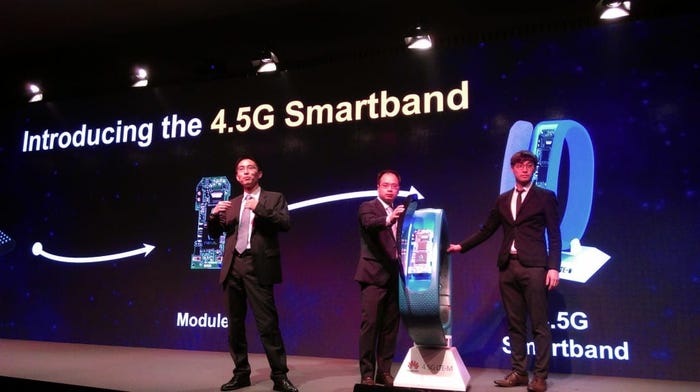Huawei unveils technology strategy underpinned by 4.5G ahead of MWC 2015Huawei unveils technology strategy underpinned by 4.5G ahead of MWC 2015
Huawei has made a host of announcements ahead of Mobile World Congress 2015, offering a peek at its LTE-connected smartband and unveiling plans for a commercialised 4.5G technology next year. These were unveiled as part of the firm’s digital transformation strategy dubbed ROADS (real-time, on-demand, all-online, DIY and social) at an event in London, attended by Telecoms.com.
February 25, 2015

Huawei has made a host of announcements ahead of Mobile World Congress 2015, offering a peek at its LTE-connected smartband and unveiling plans for a commercialised 4.5G technology next year. These were unveiled as part of the firm’s digital transformation strategy dubbed ROADS (real-time, on-demand, all-online, DIY and social) at an event in London, attended by Telecoms.com.
The Chinese vendor claimed it is on track with its 4.5G strategy, saying the technology will be ideal for the IoT. “4.5G will be the first wireless network focused on people and things and things and things. This is a big, big change from connection between people to connection between people and things and connection between things and things,” Ryan Ding, Huawei Product and Solutions President told the audience.
During the presentations, the firm showcased a massive replica of the smartband, and although details of the exact device specs were not yet disclosed, the vendor revealed it monitors bodily functions such as temperature. On the technology side, the band utilises Huawei’s new LTE-M chip technology.

According to Huawei, the LTE-M chip, developed by start-up outfit Neul acquired by Huawei in September, offers superior capacity and battery life. “In terms of capacity, LTE-M will provides 100 times the capacity of 4G networks, and also most importantly 4.5G supports deep coverage, 100 times that of 2G networks,” Bob Cai, Vice President of Marketing, Wireless Product Line Huawei said. “But most importantly the low power consumption, LTE-M is able to support 10 years of battery lifecycle.”
Huawei said LTE-M will also be used in drones, smart metering and immersive virtual reality goggles, all of which were also presented on stage, thus, according to the firm, forming a whole concept of cellular IoT. “Machine to machine is not a new concept but it’s mainly limited on the short distance communications like wifi and Bluetooth whereas cellular allows for longer distance communications,” Cai said. So this means cellular IoT will work across industries and its reach will stretch to many areas. We believe that the next five years will be a booming time for the cellular IoT.”
In terms of timelines, Cai said 4.5G is the ‘in-between-stage’ of 4G and 5G. But he was keen stress it is valuable to operators in its own right claiming it will reduce latency by 80%, support 100 times more connections per cell than 4G and boost cell capacity Gbps level.
“4.5G is a natural evolution of LTE, and supports new business opportunities and an improved user experience through enhancement of the mobile network’s capacity and capability,” Cai said. “This in turn will transition our industry into an all-online world with ultra-high speed massive connections and low latency, allowing all of us to be fully prepared for the large-scale arrival of applications for cellular IoT.”
Huawei also introduced a cloud offering called FusionCloud Omni, a solution the firm’s CTO of Data Center Solutions, Ronald Raffensperger, claimed responds to operators’ changing requirements. “One of the challenges that operators have is that their business is changing,” Raffensperger said. “It’s changing because of video, it’s changing because of the demands of the always-on connected capabilities, the fact that everything is going to be communicating, there’s going to be billions of [connected] devices. That also presents many opportunities for operators, and one those is around cloud computing.”
According to Raffensperger, key considerations for telcos are openness and collaboration, which he said the FusionCloud Omni supports. He claimed the solution enables interoperability between private and public clouds essentially forming a hybrid cloud self-service system.
The collaborative element is also part of what Huawei has branded SoftCOM Openness & Cooperation Campaign. This focuses on the NFV and SDN space and aims to encourage concerted efforts for these new technologies between different industry partners.
During the event Huawei’s Senior Director of Solution Marketing, Jean-Marc Cabrol, also stressed the importance of video, and introduced the vendor’s high frequency router (HTR) solution for ultra-high definition (uHD) video for mobile devices. He claimed it offers three times the throughput of current networks by optimising existing networks as well as in future infrastructure.
“In the last several years we’ve seen mobile service providers, we’ve seen fixed service providers joining forces, coming together through mergers and acquisitions, developing strategic assets from content,” Cabrol said. Video is the major aspect of the content that is driving this. The ecosystem is ramping up, the question is, are the networks ready.”
He claimed with HTR there will be zero waiting, no image defect and no lag in video streaming. “Ultimately HTR will enable u-HD in the existing network infrastructures despite the imperfections of those network infrastructures.”
About the Author
You May Also Like










.png?width=300&auto=webp&quality=80&disable=upscale)


_1.jpg?width=300&auto=webp&quality=80&disable=upscale)